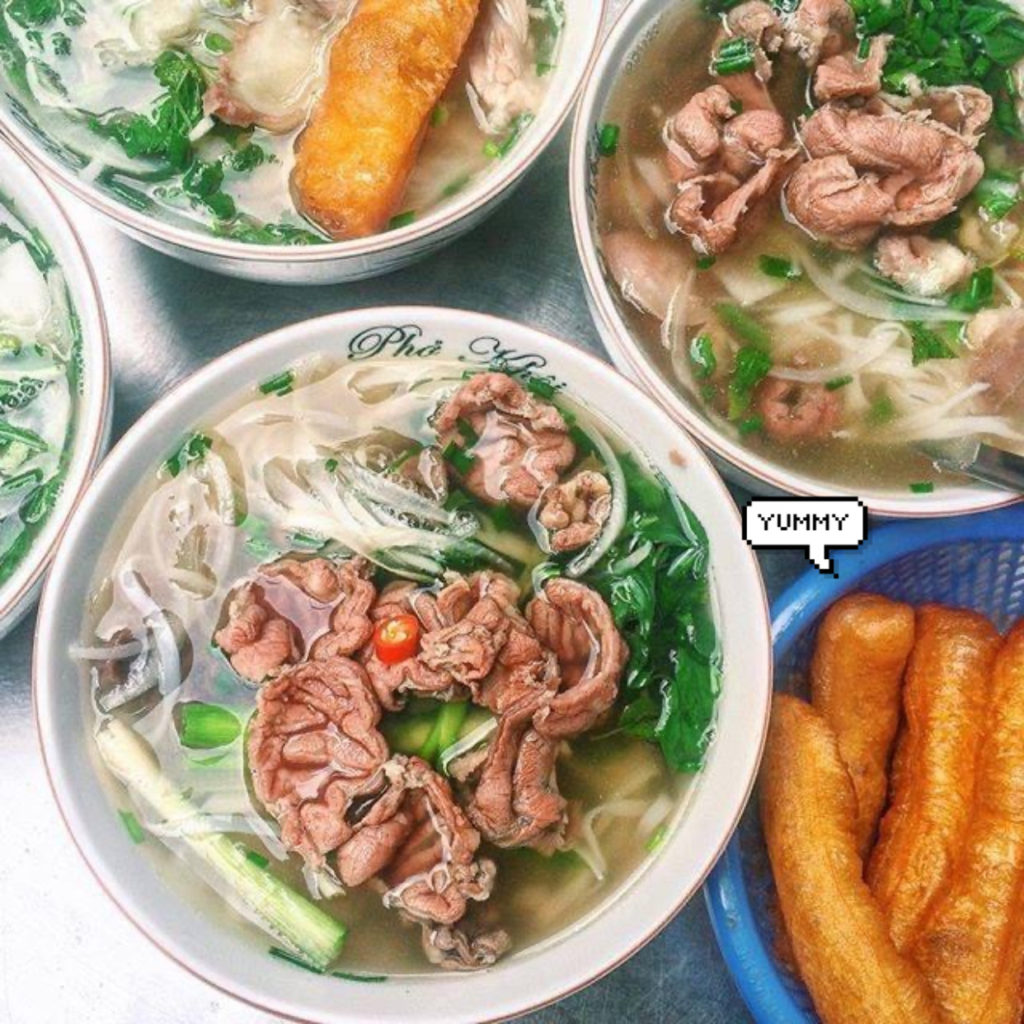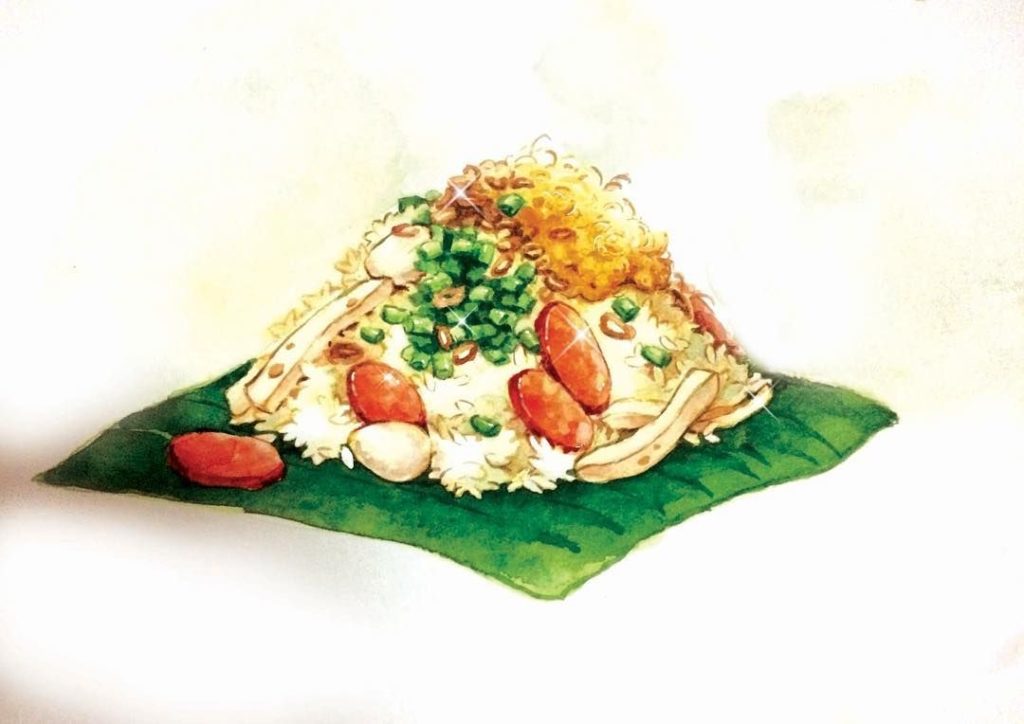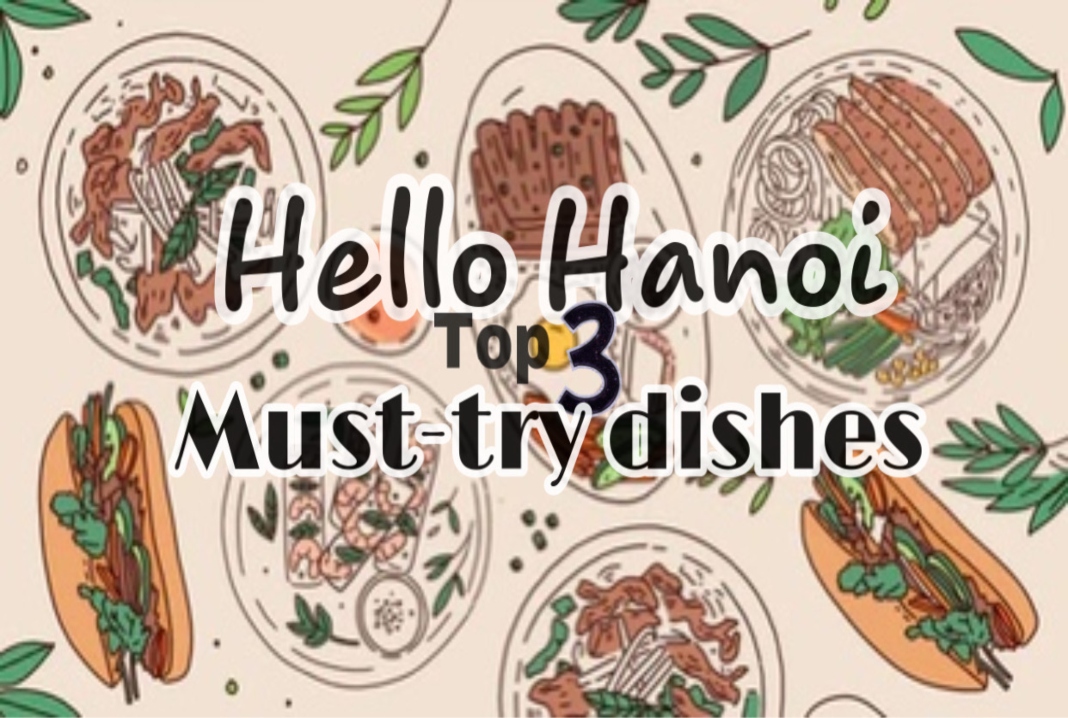Hanoi, Vietnam is well-known for its status as a treasure for cuisine. Every dish covers a part of Vietnamese history and being rich in flavor is an added bonus. Famous Vietnamese dishes are untouchable, which confuse a great number of tourists when they plan to visit Vietnam. In this food tour, other than tasting the top 3 dishes in Hanoi, virtual tourists will have a chance to learn how to pronounce the names of these dishes.
1) Phở – /f ə:’/

Phở is a Vietnamese national dish. This is one of the most complicated Vietnamese dishes to cook at home. Home cooks are required to have a myriad of techniques to cook Phở. It starts with white thin noodles made from rice flour. The broth of Phở is the soul of the dish, and is cooked after simmering ingredients from 8 to 10 hours in a big pot. The first group of ingredients Vietnamese put in the broth include grilled onions, scallions, and gingers. Next, comes stir-fried star anise, peppers, cinnamon sticks, cardamom pods, coriander seeds, coriander roots, rounded out by sugar-canes and tubular bones from cows and pigs. The secret of Vietnamese culinary is using spices with natural flavors. The sweetness from those natural ingredients also contributes to the irresistible herbal aromas that can win over anyone’s senses. To balance the sweetness of the broth, Vietnamese will add fish sauce, which is the national sauce of Vietnam. Fish sauce is made from fermented fish. The natural saltiness from the fermented fish will spice up the flavor of the broth. After simmering for over 8 hours, the Vietnamese move on to present the bowl of Phở. This process reflects how skillful Vietnamese are. First, they will boil the white ceramic bowls in water for 5 to 10 seconds. This way, the bowl of Phở is always hot. Phở will be added first, then some slices of beef or chicken depending on the eaters. The chef will add a sprinkle green onions. Finally, flavorful broth will be added broth on top.

Phở was for the wealthy during the war times because of its sophistication. However, it became prevalent among people from different classes after the country division in 1954. A bowl of Phở contains enough nutrition needed for a day. The traditional Hanoians love eating Phở in the morning, especially in the transition of fall to winter. A hot bowl of Phở with several thin medium-rare slices of beef can steal the hearts of the eaters. In southern Vietnam, they prefer eating Phở with raw vegetables, while Hanoians do not.
To eat this dish, Hanoians use bamboo chopsticks and spoons. They always taste the broth to make sure that it is satisfying. Some add a spoonful of garlic vinegar, and chilies paste to raise the flavors. In their spoon, they will put on top some slices of Phở, a slice of meat, a couple of slices of green onions, with a little bit of broth, the incredible flavor will explode in their mouths. Luisa Nguyen, studying Spanish at Hanoi University, said “Phở is phenomenal. I eat Phở almost every morning before school. Sometimes I have to skip my lunch because I’m so full.”
A bowl of Phở can range from 35,000 VND ($1.50) to 60,000 VND ($2.60). While it is prevalent in Hanoi, tourists should not go to the restaurants to eat Phở. Phở in the restaurants is not as delicious as other street vendors.
Location: 17 Thụy Khuê, Thuỵ Khuê, Tây Hồ, Hà Nội
2) Xôi Xéo – /soi-se’o/

Many people are confused by the name of Xôi Xéo. “Xôi” is the glutinous rice while “Xéo” is Vietnamese slang for “go away”. People always joke that Xôi Xéo is trying to push people away from it. Xôi Xéo is a piece of culinary art, and the cook is more than an artist. The dish starts with white sticky rice, which was soaked in the warm water overnight with a generous pinch of turmeric powder before cooking to create the honey mustard color. Then, the chef will steam the rice for about 15-20 minutes, depending on the amount of rice. The same preparing and cooking processes is repeated with the mung bean. The cool thing about the steamed mung bean is that after cooked, Hanoian will shape it into a ball. Then, they will use a sharp knife to cut it into thin slices. Some culturists believe that the word “Xéo” originates from this. It refers to the sharpness of the knife used to cut the mung bean ball. Bella Tran, a Vietnamese food blogger shared her opinions about Xôi Xéo. “I would say this is a gift from nature. We have proteins, fibers, fat, and other macro-nutrients substances in one dish, and less than $1 to have a full package of nutrition, I will get ten.”

Xôi Xéo will be put on top of the banana leaves. After adding a tablespoon of oil after frying scallions, slices of green beans go on top along with a handful of fried scallions. In the modern-day, people might add Vietnamese or Chinese sausages, however, the traditional flavor is still the winner of the game.
Hanoians love eating Xôi Xéo in the morning. Just like Phở, Xôi Xéo is nutritionous for a day. A box of Xôi Xéo costs only 10,000 VND ($0.50) to 20,000 VND ($1.00).
Location: 31 Lý Thường Kiệt (Ngã Tư Lý Thường Kiệt – Hàng Bài), Hoàn Kiếm, Hà Nội
3) Bánh Mì – /’ba’ ŋ̟-mi`/

Bánh Mì used to be called the Vietnamese baguette. Many people state that Bánh Mì was inspired by the French baguette during the colonial time. Culturists figured out the differences between Bánh Mì and French baguette. According to World Grain, French baguettes are characterized by delicate shaping and long fermentation times, while Vietnamese baguette shaping is a noisy affair with lots of slapping and rolling. The Vietnamese prefer a fluffier, melt-in-your-mouth crumb with finer and even air pockets. Bánh Mì is all about the crunchiness when people press them.
To talk about all of the fillings in Bánh Mì might take days. The traditional Bánh Mì has only Vietnamese ham. In the past, people ate Bánh Mì with condensed milk. Later on, when people had more money, they started putting Vietnamese ham into the filling. When the French conquered Vietnam, they introduced the pâté culture. The Vietnamese are creative as they mixed pâté with eggs and fried them. Interestingly enough, Bánh Mì with pâté with fried eggs is well-known not only in Vietnam, but all over the world. Many people probably know about the Balance Theory in cooking in Vietnam, especially in the land of the capital. Vietnamese add more vegetables inside Bánh Mì to balance the dish. Some places add coriander; some add cucumbers; but the most popular types of veggies are pickled carrot, cucumber, and white radish. Bánh Mì has grilled meat, skewers, spicy dried beef, Chinese sausages, char siu, meatballs with tomatoes sauce, etc.

Bánh Mì is an incredible dish for all people. You don’t have to be rich to own a loaf of Bánh Mì every morning. Bánh Mì can be enjoyed at any time of the day, but is most popular in the morning and afternoon. Students always have a loaf of Bánh Mì with a lot of filling inside before they go to school. After school, some of them have another loaf of Bánh Mì to study. This trend is popular among senior students when they have to study a lot for their tests. “Cheap, convenient, and nutritious – those are my criteria to choose my food. I’m super busy with my PhD degree, so Bánh Mì is always my perfect choice,” said by Phuong Do, majoring in Culture and Digital Media.
Location: 38 Đinh Liệt, Hà Nội
After this virtual food tour, many would understand why Vietnamese dishes always rank highly in the gastronomy world chart. With only $1 to $3, everyone can have a full meal and energy to work.





























I’m hungry when I read this article 😂
Somebody give me all of those dishes! I’m starving (: Thank you Sang for sharing!
I’m in love with Vietnamese culinary. It’s awesome and one of a kind. Thanks for sharing. You makes me feel hungry 😅
Amazing article about Vietnamese food! This makes me want to visit Vietnam right away.